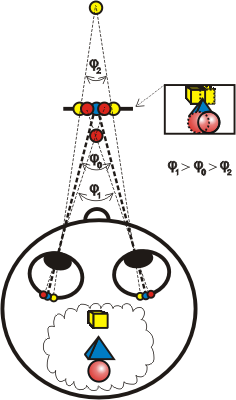5.1 Perception of three-dimensional images
When viewing a stereo pair (or a multi-frame lenticular image), for the left eye a left image of a stereo pair is demonstrated, and for the right eye a right image. Thus, a situation of observing a real world with two eyes is modeled. However, viewing a stereo photo has one important difference: eyes accommodation (focusing) takes place on the plane of a picture(image media) and stereo effect occurs only due to the convergence. This artificial separation of sight mechanisms produces an unexpected result - the stereo effect is perceived better than in real life and produces a stronger impression. It happens because the human eye is focused on the object which your attention is concentrated on, observing the real world. This makes the background and the foreground seem blurred. On the contrary, when viewing a stereo photo (taken with a large focusing depth), every thing seems clear on the scene.

Fig. 10. Three-dimensional image reconstruction
The scheme of stereo perception is shown in Fig. 10. When you are looking at a stereo picture, the following happens:
- objects with zero parallax are seen with the convergence angle φ0 and perceived as located on the key plane (the blue dot in the picture);
- objects having positive parallax in the image (red dots) are seen with the convergence angle φ1 and perceived as located in front of the key plane;
- objects with negative parallax (yellow dots) are seen with the convergence angle φ2 and perceived as located behind the key plane.
The nature of this phenomenon lies in the ability of the eye-brain system to process information within some range Delta phi (∆φ = φ1 – φ2) of the convergence angle and merge conjugated images into one three-dimensional image. The maximum delta phi range is several degrees. If the parallax of images in a stereo photo exceeds the abilities of the brain to merge images, it becomes less comfortable to view the image and you can see it double. That is why it is important to choose a stereo base correctly when you take stereo photos.